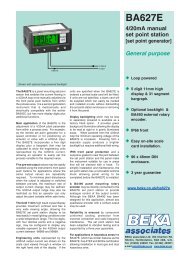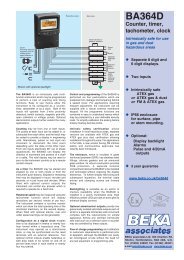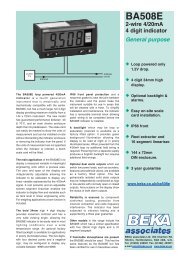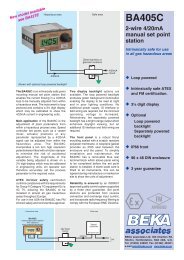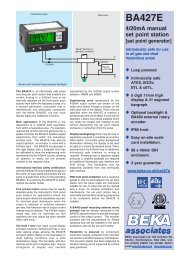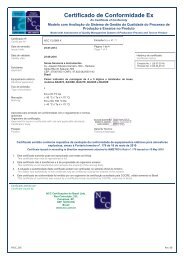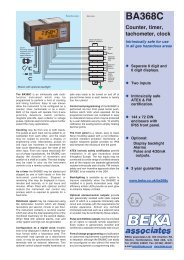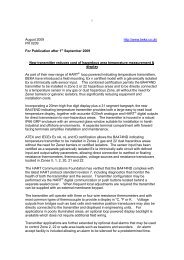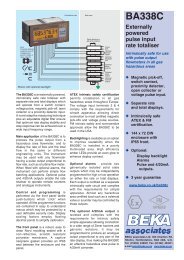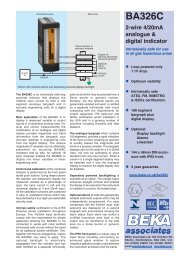Application Guide AG385 - BEKA Associates
Application Guide AG385 - BEKA Associates
Application Guide AG385 - BEKA Associates
Create successful ePaper yourself
Turn your PDF publications into a flip-book with our unique Google optimized e-Paper software.
APPLICATION GUIDE <strong>AG385</strong>BR385 Intrinsically safe sounder1. IntroductionThe BR385 is a third generation intrinsically safe sounder whichproduces a loud warning signal in a hazardous area. Forty ninedifferent fi rst stage alarm sounds can be selected by internalswitches, and each one can be externally changed to a second orthird stage alarm sound - see tone table on the BR385 datasheet.3. Supply voltageThe BR385 sounder has been designed to operate in a hazardousarea from an 8 to 28V dc supply via a Zener barrier or galvanicisolator. The sounder may be tested or used in safe areas withouta Zener barrier or galvanic isolator, but at supply voltages above16V the internal thermal current limit will function and the audiooutput may be reduced. Direct connection to supplies up to 28V ofeither polarity without a Zener barrier or galvanic isolator will notdamage the sounder, but it is recommended that it is not operatedcontinuously with a supply greater than 16V.4. ATEX Intrinsic Safety Certification for Installationin EuropeThe BR385 complies with the European ATEX Directive94/9/EC and has been issued with a Group II, Category 1G,EC-Type Examination Certifi cate. Subject to local codes of practice,the sounder may be installed in any of the European Economic Area(EEA) member countries. ATEX certifi cates are also acceptable forinstallations in Switzerland.4.1 Zones, Gas Groups and T ratingThe BR385 has been certifi ed Group I, Category IIG EEx ia IICT4. When connected to an approved system the sounder may beinstalled in:Zone 0explosive gas air mixture continuouslypresent.BR385 Intrinsically safe sounderZone 1explosive gas air mixture likely tooccur in normal operation.2. DescriptionFig 1 shows a simplifi ed block diagram of a BR385 sounder. Thedevice operates immediately power is applied to terminals 1 and 4which are duplicated to allow a second sounder to be connected inparallel, or for an end of line monitoring resistor to be installed. Theoutput tone is defi ned by the positions of the six internal switches,this tone can be changed to a second or third stage alarm tone byconnecting terminal 2 or 3 to 0V (terminal 4). The tone generator iscrystal controlled to ensure that when two sounders are started atthe same time the output tones remain synchronised Zone 2explosive gas air mixture not likely tooccur, and if it does,it will only existfor a short time.Be used with gases in groups:Group A propaneGroup B ethyleneGroup C hydrogenHaving a temperature classifi cation of:T1450 o CT2300 o CT3200 o CT4135 o CAt ambient temperatures between –40 and +60 o C. Fig 1 Simplified block diagram 4.2 Terminals 1 & 4Power is supplied to the sounder via terminals 1 & 4 which havethe following input safety parameters:Ui = 28VIi = 93mA dcPi = 0.66WBR385 sounders may therefore be powered from any Zener barrieror galvanic isolator certifi ed [EEx ia] by an EC Approved Notifi edBody, having output parameters equal to, or less than 28V, 93mAand 0.66W.
2The equivalent internal capacitance Ci and inductance Li at theseterminals are both zero.CautionPlease note that the input safety parameters for the earlierBA385 sounder were Ui = 28V, Ii = 110mA, Pi 0.8W. Care shouldtherefore be taken when replacing a BA385 with a BR385sounder to ensure that the lower input safety parameters of thenew model are not exceeded.4.3 Terminals 2 & 3When sounder terminals 2 or 3 are connected to 0V (terminal 4),the sounder output tone changes to the second or third stage alarmrespectively. The input safety parameters for these terminals are:Ui = 28VIi = 0mABecause the permitted input current is zero, these terminals mayonly be connected to a certifi ed diode return barrier or to thecontacts of a certifi ed intrinsically safe relay or galvanic isolator.For operational reasons, only diode return barriers with a voltagedrop of 0.9V or less may be used.The equivalent internal capacitance Ci and inductance Li at theseterminals are both zero.5. Factory Mutual approval for installations in USAFor installations in the USA the BR385 sounder has been approvedby Factory Mutual as intrinsically safe for Class I, Divisions 1and 2.Installations must comply with <strong>BEKA</strong> Control DrawingCI385-32, ANSI/ISA RP12.6 and the National Electrical CodeANSI/NFPA70.The FM Certifi cate of Compliance and the <strong>BEKA</strong> Control DrawingCI385-32 may be downloaded from the <strong>BEKA</strong> web site or requestedfrom the <strong>BEKA</strong> UK sales offi ce or in the USA from:Exloc Instruments IncPO Box 861406WarrentonVA 20187USATel: 540 428 3088Fax: 540 428 3028e-mail: info@exloc.comwww.exloc.com5.1 Divisions, Gas Groups and T ratingThe BR385 sounder has been approved intrinsically safe by FMfor installation in the following Divisions and used with the followinghazardous:Installation in:Division 1Division 2Use with Class I gases in groups:Ignitable concentrations of fl ammable gases,vapours or liquids can exist all of the timeor some of the time under normal operatingconditions.Ignitable concentrations of fl ammable gases,vapours or liquids are not likely to exist undernormal operating conditions.Having a temperature classifi cation of:T1 450°CT2 300°CT3 200°CT4 135°CIn an ambient temperature between –20 and +60°C.Note: The BR385 is not approved for use with Class II and IIIdusts and fi bers.5.2 Intrinsic safety parametersThe BR385 sounder has been evaluated under the entityconcept and the FM safety parameters are identical to the ATEXparameters except that the maximum cable capacitance whichmay be connected between terminals 1 and 4 is specifi ed. InATEX systems the maximum cable capacitance is the Co of theZener barrier or galavanic isolator powering the BR385 sounder.5.3 Terminals 1 and 4Power is supplied to the sounder via terminals 1 & 4 which havethe following input safety parameters:Ui = 28VIi = 93mA dcPi = 0.66WBR385 sounders may therefore be powered from any FM approvedZener barrier or galvanic having output parameters equal to, orless than 28V, 93mA and 0.66W.The total capacitance connected to terminal 1 and 4 must notexceed 83nF.CautionPlease note that the input safety parameters for the earlierBA385 sounder were Ui = 28V, Ii = 110mA, Pi 0.8W. Careshould therefore be taken when replacing a BA385 with aBR385 sounder to ensure that the lower input safety parametersof the new model are not exceeded.5.4 Terminals 2 & 3When sounder terminals 2 or 3 are connected to 0V (terminal 4),the sounder output tone changes to the second or third stage alarmrespectively. The input safety parameters for these terminals are:Ui = 28VIi = 0mABecause the permitted input current is zero, these terminals mayonly be connected to a FM certifi ed diode return barrier or to thecontacts of a FM certifi ed intrinsically safe relay. For operationalreasons, only diode return barriers with a voltage drop of 0.9V orless may be used.The equivalent sounder internal capacitance Ci and inductance Liat these terminals are both zero.6. Electrical System Design for Installation inHazardous Areas using Zener barriersThe recommended circuits in this section may be used forinstallations covered by both ATEX and FM certifi cation. Bothapprovals are based on the entity concept.Group AGroup BGroup CGroup DAcetyleneHydrogenEthylenePropane6.1 Single stage alarmThe BR385 sounder may be powered from any appropriatelycertifi ed Zener barrier having output parameters equal to or less28V, 93mA, 0.66W. If the sounder control switch is in series with
3the positive supply, or the power supply is being turned on andoff, only a single channel Zener barrier is required to power thesounder as shown in Fig 2. This circuit may also be used if amechanically activated switch on the hazardous area side of thebarrier is controlling the sounder.two alarm stages are required the third stage barrier should beomitted. For a two stage alarm the required 28V, 93mA Zener barrierplus a diode return barrier is an industry standard combinationavailable in a common package from a variety of manufacturers.For operational reasons, only diode return barriers with a voltagedrop of 0.9V or less may be used.BR385sounder14Barrier28V 300positiveOn/Off+0VPowersupply7. Electrical System Design for Installation inHazardous Areas using Galvanic isolators.Galvanic isolators, although more expensive than Zener barriers,do not require a high integrity earth connection. For small systemswhere a high integrity earth is not already available, the use ofgalvanic isolators often reduces the overall installation cost andsimplifi es design.Fig 2 Single stage alarm using single channel barrier.If the sounder control switch is in series with the negative supply, asecond barrier is required as shown in Fig 3. A diode return barrieris ideal for this application, any type may be used providing it hasthe same polarity as the barrier supplying the sounder and it’soutput safety parameters are equal to, or less than 28V and 0mA.7.1 Single stage alarmThe BR385 sounder may be powered from any appropriatelycertifi ed galvanic isolator having output parameters equal to or lessthan the maximum input parameters specifi ed by the sounder ATEXor FM certifi cation. The sounder may be controlled by turning thegalvanic isolator on and off, by a mechanically operated switch inthe hazardous area wiring, or with some isolators via a dedicatedsafe area switch - see Fig 5.BR385sounder14BarrierDiode returnbarrier28V 300positiveOn/Off+0VPowersupplyBR385sounder14+_Galvanic isolatoron/offPowerFig 5 Single stage alarm using galvanic isolator.Fig 3 Single stage alarm using two channel barrier.6.2 Multi-stage alarmConnecting sounder terminals 2 to 0V (terminal 4) activates thesecond stage alarm; similarly connecting sounder terminals 3 toto 0V (terminal 4) activates the third stage alarm. Mechanicallyoperated switches in the hazardous area may be used to selectthese alarm stages, or the control may be transferred from the safe(unclassifi ed) area via an intrinsically safe relay or diode returnbarrier. Fig 4 shows how diode return barriers may be used. If only7.2 Multi-stage alarmFig 6 shows a typical application in which the BR385 sounderis activated when Alarm 1 of a BA327C intrinsically safe looppowered indicator closes. When Alarm 2 closes and the sounderoutput changes from the fi rst to the second stage tone.The indicator has galvanically isolated solid state switch outputswhich have been certifi ed as simple apparatus, allowing directconnection to the BR385 sounder.BR385sounder1234BarrierDiode returnbarrierDiode returnbarrier28V 300positiveOn/Off2nd stage3rd stage+Powersupply0V8. Cable parametersThe maximum permitted cable parameters for each confi gurationare determined by Co and Lo of the Zener barrier or galvanicisolator to which the BR385 sounder is connected. For installationscovered by the sounder FM approval, the maximum totalcapacitance connected between the power supply terminals 1 and4 of the BR385 sounder must not exceed 84nF.Permitted cable inductance is not restrictive, only with cablelength of 300m is the permitted 84nF capacitive limit likely tobe approached. A typical pair if wires in a multicore cable has acapacitance of 250pF/metre and an inductance of 1µH/metre.Fig 4 Multi-stage alarm using Zener barriers
42-wiretransmitter4/20mA4/20mAAcceptswitch56BA386beacon12Barrier28V 93mApositiveon/off+Powersupply1 3BA327C looppowered indicator4/20mA galvanic isolator31(+)44(0V)0VAlarm 198 10 11Alarm 2BR385sounder11st stagealarm2nd stagealarm24+_PowerBR385 sounderFig 7 Combined circuit for BR385 sounder and BA386 beaconFig 6 Loop-powered BA327C intrinsically safe indicator controllingBR385 fi rst and second stage alarms.9. Operating BR385 sounders in parallelTwo BR385 sounders may be powered from a single Zener barrieror galvanic isolator, but the output of each one will be reducedby about 3dB. It is possible to operate three devices in parallel,but this should only be done when the maximum supply voltageis available.10. Use with BA386 LED flashing BeaconThe BR385 sounder may be powered from a BA386 intrinsicallysafe fl ashing beacon to form a combined audio-visual alarm withan alarm accept push button which silences the sounder. Thiscombination is ideal for applications where an operator needs to beadvised that an alarm condition has occurred, but wishes to silencethe intrusive audible warning while leaving the beacon fl ashing.If the alarm condition is not corrected during the pre-set silenceperiod, which can be between 1 and 30 minutes,the sounder willbe reactivated when the silence time has expired.The BA386 fl ashing beacon has both ATEX and FM intrinsicsafety certifi cation. This combination of a BR385 sounder anda BA386 beacon may be used for installations covered by ATEXcertifi cation. The combination is not yet included in the BA386FM Control Drawing although interconnection may be made usingthe entity concept.<strong>BEKA</strong> associates Ltd.Old Charlton Road., Hitchin, Herts. SG5 2DA UK Tel: (01462) 438301 Fax: (01462) 453971 e-mail sales@beka.co.uk www.beka.co.uk04



